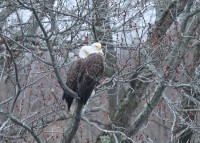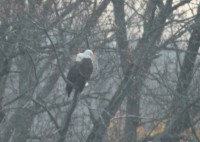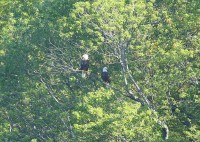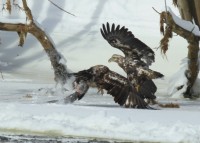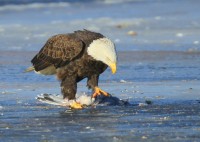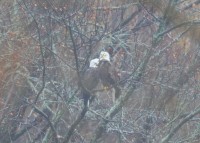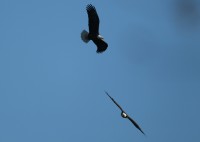 While checking on a pair of nesting Bald Eagles along the Merrimack River, observed the male launch into flight from a perch on back side of the nest tree. He made a large aerial loop and then seemed to go into a stall above a taller nearby pine tree. Then he began to descend with legs and talons outstretched while making loud calls. To my surprise, a female was atop the pine tree and bowing forward. Up until now, I’m under the impression that at least one chick has hatched and should be large enough to be seen fairly soon, based on prior feeding observations. The bald eagles engaged in a copulation sequence that lasted just a few seconds. Found some commentary on the web that perhaps explains the behavior:
While checking on a pair of nesting Bald Eagles along the Merrimack River, observed the male launch into flight from a perch on back side of the nest tree. He made a large aerial loop and then seemed to go into a stall above a taller nearby pine tree. Then he began to descend with legs and talons outstretched while making loud calls. To my surprise, a female was atop the pine tree and bowing forward. Up until now, I’m under the impression that at least one chick has hatched and should be large enough to be seen fairly soon, based on prior feeding observations. The bald eagles engaged in a copulation sequence that lasted just a few seconds. Found some commentary on the web that perhaps explains the behavior:
1. Sometimes the male initiates the act, but the male must be careful approaching the larger female, and occasionally, the female injures or even kills the male (Wolfe and Bruning, 1997). In most cases, the female initiates mating. She bows her head, spreads her legs, and raises her tail. The male then approaches the female with his tail raised. The female emits a single-note call, and the male clenches his talons so he won’t hurt his mate and then climbs on her back. He lowers his tail and cloaca to meet the female’s as she raises her tail and cloaca. Copulations occur often during the breeding season but slow down once the eggs are laid and stop after the eggs hatch (Wolfe and Bruning, 1997) .
2. In the book “The Bald Eagle,” eagle biologist Mark Stalmaster says, “Copulation takes place in as little as five to fifteen seconds, but can last one to two minutes, and may occur several times a day. Most copulations occur from six days before to three days following the laying of the first egg. Sex is more common in the early morning hours. The sex act, however, has been observed after construction of the nest, and might even happen outside the breeding season.”
For those with an interest, more sequence photos posted: http://www.pbase.com/birdshots/image/155168871
Click “next” in upper right corner to advance frames!
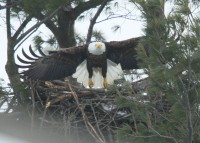 Made a pass by the Bald Eagle nest near the Merrimack River in western Essex County this morning. The winds were out of the west at 12 MPH with gusts up to almost 20 MPH. The temp was 24 degrees with wind chill making it feel around 11 degrees. Noticed an adult approaching and then landing at the nest. Another adult was already perched on the outside ridge of the nest in a large pine tree. The approaching adult dropped off prey for other eagle and then took off in flight. This is a nesting pair that has been at this nest location for past bunch of years. Was just able to get a number of images that provided positive ID of the left leg gold band. This band was placed on the bird just before it fledged. This eagle was banded in June 2006 at North Watuppa Pond near Fall River!
Made a pass by the Bald Eagle nest near the Merrimack River in western Essex County this morning. The winds were out of the west at 12 MPH with gusts up to almost 20 MPH. The temp was 24 degrees with wind chill making it feel around 11 degrees. Noticed an adult approaching and then landing at the nest. Another adult was already perched on the outside ridge of the nest in a large pine tree. The approaching adult dropped off prey for other eagle and then took off in flight. This is a nesting pair that has been at this nest location for past bunch of years. Was just able to get a number of images that provided positive ID of the left leg gold band. This band was placed on the bird just before it fledged. This eagle was banded in June 2006 at North Watuppa Pond near Fall River!